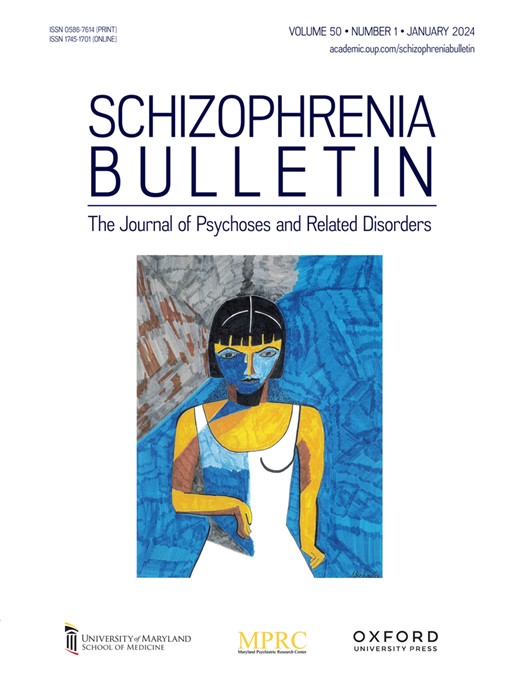迷你caarms:开发和验证一个简短版本的AT风险精神状态综合评估,以促进预防精神病学
IF 4.8
1区 医学
Q1 PSYCHIATRY
引用次数: 0
摘要
背景与假设使用现有的心理测量工具,如高危精神状态综合评估(CAARMS/2006),准确检测有精神病风险的个体,对于实施有效的预防策略至关重要。然而,CAARMS/2006的可伸缩性由于其冗长的管理而受到限制。本研究开发并验证了一种较短的CAARMS/2006版本:mini-CAARMS。研究设计共有490名参与者(平均年龄23.8±5岁)接受了完整的CAARMS/2006访谈(60项,均单独评分)。迷你caarms的开发和验证采用了先进的统计方法:在嵌套交叉验证框架内使用LASSO惩罚的正则化逻辑回归来保留核心项目;Cohen’s κ、Harrell’s C指数、敏感性、特异性、平衡准确性、阳性(PPV)和阴性(NPV)预测值评估性能;蒙特卡罗模拟评估预测精神病发病的2年预后准确性。灵敏度分析开发并验证了超迷你caarms。与完整版本相比,mini-CAARMS仅保留了23个项目,并显示出出色的准确性:Cohen 's κ 0.90;Harrell’s C指数0.93,敏感性95.6%,特异性100%,平衡准确度97.8%,PPV 100%, NPV 86.3%。mini-CAARMS的预后敏感性和特异性分别为82.2%和55.1%。敏感性分析进一步开发并验证了超迷你caarms(仅基于12个项目),达到了相当的性能,κ 0.90, C指数0.91,敏感性94.4%,平衡准确性97.2%,PPV 100%, NPV 82.2%,预后敏感性和特异性分别为81.2%和55.1%。结论mini-CAARMS保持了较高的准确性,同时大大缩短了给药时间,可促进资源匮乏地区预防精神病学工作的可扩展性。本文章由计算机程序翻译,如有差异,请以英文原文为准。
The Mini-CAARMS: Development and Validation of a Short Version of the Comprehensive Assessment of AT Risk Mental States to Facilitate Preventive Psychiatry
Background and Hypothesis Accurate detection of individuals at risk for psychosis with established psychometric instruments such as the Comprehensive Assessment of At-Risk Mental States (CAARMS/2006) is crucial to implement effective preventive strategies. However, the CAARMS/2006’s scalability is limited by its lengthy administration. This study developed and validated a shorter CAARMS/2006 version: the mini-CAARMS. Study Design A total of 490 participants (mean age 23.8 ± 5 years) underwent the full CAARMS/2006 interview (60 items, all individually scored). The development and validation of the mini-CAARMS employed advanced statistical methods: regularized logistic regression with a LASSO penalty within a nested cross-validation framework to retain core items; Cohen’s κ, Harrell’s C index, sensitivity, specificity, balanced accuracy, positive (PPV) and negative (NPV) predictive values to assess performance; Monte Carlo simulations to assess the 2-year prognostic accuracy for predicting psychosis onset. A sensitivity analysis developed and validated an ultra-mini-CAARMS. Study Results The mini-CAARMS retained only 23 items and demonstrated excellent accuracy compared to the full version: Cohen’s κ 0.90; Harrell’s C index 0.93, sensitivity 95.6%, specificity 100%, balanced accuracy 97.8%, PPV 100%, and NPV 86.3%. The prognostic sensitivity and specificity of the mini-CAARMS were 82.2% and 55.1%, respectively. Sensitivity analyses further developed and validated an ultra-mini-CAARMS (based on 12 items only), which achieved comparable performance, with κ 0.90, C index 0.91, sensitivity 94.4%, balanced accuracy 97.2%, PPV 100%, NPV 82.2%, and prognostic sensitivity and specificity 81.2% and 55.1%, respectively. Conclusions The mini-CAARMS maintains high accuracy while substantially reducing administration time, and it could facilitate scalability of preventive psychiatry in low-resource settings.
求助全文
通过发布文献求助,成功后即可免费获取论文全文。
去求助
来源期刊

Schizophrenia Bulletin
医学-精神病学
CiteScore
11.40
自引率
6.10%
发文量
163
审稿时长
4-8 weeks
期刊介绍:
Schizophrenia Bulletin seeks to review recent developments and empirically based hypotheses regarding the etiology and treatment of schizophrenia. We view the field as broad and deep, and will publish new knowledge ranging from the molecular basis to social and cultural factors. We will give new emphasis to translational reports which simultaneously highlight basic neurobiological mechanisms and clinical manifestations. Some of the Bulletin content is invited as special features or manuscripts organized as a theme by special guest editors. Most pages of the Bulletin are devoted to unsolicited manuscripts of high quality that report original data or where we can provide a special venue for a major study or workshop report. Supplement issues are sometimes provided for manuscripts reporting from a recent conference.
 求助内容:
求助内容: 应助结果提醒方式:
应助结果提醒方式:


